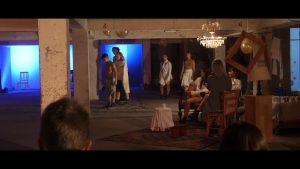By David Greig – Elia Biennale December 2016 Florence
During the Elia Biennale in Florence (December 2016) David Greig talked about the Constructed Space. Now there is the whole article. Not only for professionals in theatre but for every performer.
THE CONSTRUCTED SPACE
In 1970 The Scottish Poet WS Graham wrote a poem called ‘The Constructed Space’ In it, he imagines the poem itself as a conjuring up a space, almost like a balloon, suddenly inflated out of nothing. Inside this new space two beings encounter each other: ‘you’ and ‘I’.
In the poem ‘I’ explains the miracle of this encounter,
‘Anyhow here we are and never
Before have we two faced each other who face
Each other now across this abstract scene’
For as long as the poem is read, ‘you’ and ‘I’ can experience ourselves in a new way, liberated from the ‘disguise’ of the mortal, fleshy, physical world and its limits. Inside the poems gaps and silences we become free.
‘And yet I say
This silence here for in it I might hear you.
I say this silence or, better, construct this space
So that somehow something may move across
The caught habits of language to you and me.’
Inside the space of art, self and other dissolve, and we are briefly able to encounter each other with a liberatory empathy.
I believe that this way of understanding art, the model of The Constructed Space, is one that can be applied to all art, not just poetry. In particular I think it can be applied effectively to theatre.
Inside a poem, author and reader meet. But inside the space of a play many more encounters are possible: author meets character, character meets other character, character encounters actor, actor meets audience and so forth. Not to mention director, designer and all the other myriad collaborators who make a play. With each of these encounters a ‘self’ has to understand the point of view of an ‘other’, an ‘I’ has to listen for a ‘you.’ And, of course, when the play is on the stage, each new audience member in the room is having their own personal encounter not just with the characters, and the actors but with the reactions of the other audience members around them. The sheer volume of encounters multiplies exponentially.
A play is, in essence, a machine for manufacturing empathy on an industrial scale.
In this essay I want to expand on WS Graham’s poem and to propose that art in general, but theatre in particular, performs an important social function as a ‘constructed space’ of radical empathy. I want to propose that the power of this space applies as much to the actual physical building of a theatre, and theatre company, as it does to the abstract space of a play in performance. Lastly, I want to propose that the presence of such constructed spaces of art are essential to the proper functioning of democracy in a city.
To explore all these ideas I will to refer to my experience of adapting and staging, at the Lyceum Theatre in Edinburgh, one of the earliest plays in human existence: The Hekatides or Suppliant Women by Aeschylus. This is a play which contains both the birth of drama and the birth of democracy. It is also, I believe, a good model of how the constructed space of civic theatre can works in practice.
*
The Suppliant Women is the second oldest play in human existence. Written two and a half thousand years ago it tells the story of fifty young women from Egypt who flee forced marriages to the sons of King Aegyptos. To escape, the women build a boat, cross the Mediterranean and finally wash up on a beach in Greece where they claim asylum.
Faced with the women at the gates of his city, the Greek king, Pelasgos, considers what to do for the best. To invite the women in may bring war to the city, but to bar the women will bring spiritual pollution and shame.
Unable to decide, Pelasgos proposes that the citizens of Argos take a vote…
*
In order to make the Suppliant Women, the creative team and myself immersed ourselves in Greek theatre. We wanted to learn exactly how the first audience would have experienced the play. We researched the original music. The structure of performance. The social conditions and so on…
I am sure many of you are already familiar with Greek theatre but to briefly summarize: Greeks theatre primarily took place at festivals: in particular The Annual Festival of Dionysos in Athens. The plays were performed with music and singing. To make the plays a small number of professional actors would work together with an amateur chorus of young men. In style, Greek plays are characterized by their use of music and rythmic speech. They are also famous for their themes – power, violence, family, duty, sex… themes which go straight to the heart of what it means to be human. All the plays in a festival would be entered into a competition and the winning play and chorus would be honoured with prizes, garlands and statues.
As I explored the Greek world I began to wonder if perhaps the Greeks, by inventing theatre, has also uncovered some of the key architectural principles which go into building the constructed space of art.
Those principles are:
Fiction
Choice
Empathy
Conviviality
Participation
Community
Transcendence
Excellence
And
Silence
Let’s take each of those ideas one by one.
*
- FICTION
Although The Suppliant Women is two and a half thousand years old, the events it describes are not contemporary to its performance. It is fiction, not journalism. Aeschylus took a myth held in common by the city and he re-imagined it. He made it a story and by doing so he created another world.
As story must always bring into being its own world. The world it creates might resemble the real world. It might even parallel the real world. But if the story is any good, it will always be a world unto itself.
By offering us a fiction, Aeschylus allows us to enter a different world, and in so doing, he offers us the chance to see, as if for the first time, our own world.
The constructed space allows us to enter a different world.
*
CHOICE
Like most Greek tragedy, The Suppliant Women is centred around an impossible choice. If the city welcomes the women they will bring war. But if the city does not welcome the women it will bring shame. When these two aims are in conflict, what is the correct course of action?
It’s a classic Greek dilemma because it is insoluble. There can be no correct answer.
Wrestling with impossible dilemmas is, perhaps, a defining feature of being human. No person goes through life deliberately wishing to do the wrong thing. Perhaps the most common experience of us all is that of wishing to do right thing but nevertheless experiencing the fact that somehow everything still turns out wrong.
By taking a clear, rational eye to the most important issues of its day and then finding within those issues not a lecture, nor an example, nor propaganda, nor an illustration but instead: an dilemma, a choice – Greek drama takes two hands to the surface of the world and wrenches open in it a space for the human.
The constructed space contains a choice.
*
EMPATHY
The Suppliant Women was written by Aeschylus at a time when Athens was undergoing a migrant crisis. The city was at the centre of a growing empire. Large numbers of foreigners were coming to live and work in the city. For the male citizens of Athens it was suddenly unclear who should be regarded as ‘a citizen’ and who should be consigned to second class status.
In this context then, we see that at the centre of The Suppliant Women is an extraordinary act of empathy – because Aeschylus has made the central protagonist of his play a doubly marginalised group – migrant women.
Take for example this short fragment. In this moment all is lost. The city has not yet taken the women in, and from their sanctuary on a cliff top they can see the sails of their tormentors speeding towards them. The women face capture or death.
In a song the girls imagine their escape…
Oh Argos
Is there some summit
A chair in the clouds
A cliff-top I can climb to
High up in the mountains
A summit so high
Even goats cannot reach it
Isolated Overhanging
Mist turning to snow on my skin.
I will shiver
look down
At the wings of the vultures Wheeling below
Awaiting my fall.
Oh Argos
Will you watch
As I step into emptiness.
Will you witness my protest,
My thousand foot silence?
Remember, of course, that this speech would have been spoken by a member of the chorus: a man. Aeschylus is requiring the privileged young men of Athens to put themselves into the shoes of frightened refugee. The male audience has been required to follow a drama whose protagonist is a group of women seeking asylum. Empathy courses through the drama.
Almost every act in the creation of a piece of theatre requires a person to imagine what it might be like to be in someone else’s shoes.
The author must imagine being someone else.
The actors must embody someone else.
The director must imagine being an audience.
And finally, the audience, as they watch are invited think to themselves: ‘Imagine, if I was that person, what would I do?’
As my friend, the Scottish playwright Jo Clifford has said: ‘Empathy is a muscle, theatre is the gym.’
The constructed space is a space of empathy.
*
CONVIVIALITY
All Greek theatre was dedicated to the god Dionysos. As well as being the God of theatre, Dionysos was also the God of Wine. I don’t think this is a coincidence. When The Suppliant Women was first performed at The festival of Dionysos, wine would be drunk and food would be eaten. The air would have be thick with the smell of barbecued meat.
This conviviality is a central plank of the Greek theatrical experience. By eating and drinking with our fellow citizens we are reminded that they are humans. We experience each other in our embodied forms: we laugh, we burp, we fart, we cry. We are human together.
In this atmosphere of conviviality we feel welcomed and enabled to face the play on the stage and therefor to go deep into darkness, terror, complexity and rage.
In the audience, rub up against each other, hold hands and draw strength from our shared humanity as we watch our own darkness played out before us.
In the constructed space we are convivial.
*
PARTICIPATION
Berthold Brecht said ‘theatre is a transformative art, but those it transforms the most, are those who make it.’ This was certainly a principle with which the Greeks were familiar.
Participation in a chorus was considered a religious duty for young men in Athens. It was almost a form of national service. Politicians would refer to their ‘fellow chorus members’ with the same affection an old soldier would think back to the men in his platoon.
(Personally, think a very great deal of the problems of democracy might be solved if we were to introduce a system of compulsory national service but instead of going into the army – everyone would have to spend a year in a musical theatre chorus. It’s not easy to be a fascist whilst performing a kick line in Oklahoma.)
The constructed space is built from participation.
*
COMMUNITY
All male citizens of Athens would attend the festival of Dionysos. The Suppliant Women was performed in front of something akin to a football crowd. These plays were for everyone.
(Now of course they weren’t for everyone. They weren’t performed to women. This is a fascinating and difficult exclusion. It can’t be ignored and it’s something I will come back to… but for now… stay with me.)
The Greeks knew that the theatre’s power was only fully released when it was attended by every citizen.
Everyone must have access to the constructed space.
*
TRANSCENDENCE
Greek drama began as a religious ritual of music and dance: the Tragos or Goat Song. The use of music, light and rythym to create transcendence is, of course, common to most spiritual traditions around the world. But the Greeks systematized this relationship in the figure of Dionysos, the god of Theatre, who is also the god of Dance and Trance.
In the wordless swirl of dance, trance, rhythm and light we, as the audience, are lifted out of our mortal disguise and offered transcendence.
We enter the constructed space shorn of our daily selves: vulnerable and open.
*
EXCELLENCE
When we were making The Suppliant Women there were many arguments. Ramin, John, Sasha and myself would argue about what the original performance might have been like. How should we approach the performance to achieve the right effect? and so on.
At one point we were having a very heated argument over ‘what Aeschylus would have wanted.’ The argument flew back and forth until Barnaby Brown, our aulos player, made a surprising comment. ‘Aeschylus,’ he said, ‘would have wanted to win.’
Barnaby comes originally from the world of Scottish piping. Scottish piping, like many traditional art forms is artisanal rather than expressive and it often finds its artistic zenith in competition. Pipers compete at highland games to win gold medals. Because of his background something was obvious to Barnaby which had passed the rest of us by.
Aeschylus would have wanted to win the competition.
By demonstrating excellence Aeschylus would have achieved two things. First, he would have honoured the gods with the very best he had to offer, and second he would demonstrated to his audience the greatness that lay within them.
The constructed space is a celebration of human excellence.
*
So we see that we find in the Greeks, the inventors of drama, the main planks of the constructed space: fiction, choice, empathy, community, conviviality, transcendence, participation, and excellence…
But I think there is still one quality missing: silence.
*
In WS Graham’s poem he clearly states:
‘I say this silence here that I might hear you’
*
SILENCE
Surely The Constructed Space must contain silence.
There is between ourselves and the Greeks, two and half thousand years of great silent darkness. That is surely silence enough in which to find ourselves. But still, I wonder. Where in their theatre did the Greeks find silence?
I do not know, for certain, how the Greeks built silence into their theatre but I know where I experience it.
In the mystery of the texts themselves.
There is a deep mystery at the heart of nearly every Greek pla and it is this very unknowability which draws theatre makers back to them time and time again.
But whatever it’s source, I do know that this silence that is the most challenging thing for any artist to create. Silence is elusive. Silence is an accident. And yet surely, when we encounter any truly great work of art, it’s the silence which most compels us to come towards it.
*
Of course, the moment we think about silence we also think about the excluded voices from Greek theatre; in particular, women. The festival of Dionysos was for men only.
The performers were male. The authors were male. The audience was male.
We do know, however, that women were aware of the plays. The comical Satyr plays performed at the end of the evening often satirize female reaction to particular authors or styles of drama.
It has been speculated that, while the men were inside the open air theatre there may have been women gathered outside, in the groves, on the grass, on roof tops, or under the pines, listening to the words and songs drift from inside the theatre.
How, in amongst all this democracy and empathy, was it possible for the Greeks to exclude the voices of women? I can’t answer that question. But it does throw up, for me, a couple of thoughts…
- Who are we excluding now?
And
- Imagine them, the women, standing in the darkness on a warm night in Athens, listening to these words from Aeschylus sung out from the stage –
‘O Zeus
Most blessed king of blessed kings
Treasure bringer
Blessing giver
Mighty wave of power
Use your force to
Stop male violence.
Take the hearts of men
And plunge them
Into a lake of blood
Forever tether
The black bull of madness
To which men yoke their souls.
What space did those words open up on that night and what encounters were enabled to take place within the constructed space of those words?
*
We have discussed what ‘The Constructed Space’ is. Perhaps we ought to explore for a moment what the constructed space is not. It is not, for example, a ‘safe space’ (at least not in the sense that it is a comfortable space).
Inside the constructed space of art we encounter each other in our fully human forms and those fully human form contain, for example, darkness, terror, violence and illicit desire.
I think here of the plays of Sarah Kane, or Becket. Such plays are unflinching and dark. But because although the space they construct is bleak, these works allow all who access them to feel the full force of our shared humanity – author and reader, actor and audience – the discomfort of the darkness is shared – and sharing of the burden of the darkness becomes – in itself – a form of comfort.
*
When we add all these elements together, we see that the constructed space is a space which allows an encounter to take place between ‘you’ and ‘I’. But the architecture of the space means that this encounter is one which conjures another world, produces a dilemma, demonstrates empathy, community, conviviality, transcendence, participation, and excellence…
And so – in art – we encounter each other in our full humanity.
*
Wich is all very nice. But a summer’s day is nice. A delicious cake is nice. What is it about a work of art that makes it vital. What is it about the constructed space that DEMANDS our attention?
The Suppliant Women was performed the year before Athens underwent a democratic revolution. The play itself is focused around a vote. It is the first instance of a vote in any work of art. The play certainly contains the first instance of the use of the word ‘democracy.’
When their father returns from Argos with word that the citizens have voted for them to be allowed to stay, the Chorus ask:
‘Father – tell us! How does it work this thing called democracy’
In fact – my translation is a bad one. In the original, the word appears in the form of a typicaly Aeschylean mash up.
‘Tell us father – how does it work this democra-handy-uppy thingy.’
It’s interesting that the what is, essentially, the first play also contains, essentially, the first mention of democracy.
We are also told that the democratic process in Athens first took place in theatres.
The constructed space and the democratic space were born at the same moment.
This double birth seems to speak to a self evident truth which is this: without access to the constructed space we cannot have true democracy.
Unless we are able to encounter each other within art, then any vote taken is taken in ignorance. Democracy becomes mob rule. Without the constructed space to restore us to humanity, democracy merely becomes another form of violence.
*
This, of course, is why the political realm is so wary of the constructed space. This is why authoritarians was to shut it down.
HAMILTON ANECDOTE
*
So, in these hastening, trying times, when it feels like democracy is becoming detached from empathy and rationality. When the polity feels afraid. Surely this is the moment when it is most important for the constructed space to exist and for every citizen, and non-citizen, to be able to encounter themselves and others within it.
And is not, therefore on those of us who guard The Constructed Space, to defend our spaces against erosion? We must ensure our work opens up new worlds, we must ensure it opens up real dilemmas, we must ensure it allows access for the whole community. We must offer participation and community, but we must also aim for excellence. We must offer conviviality and encourage transcendence.
And perhaps most of all, perhaps, we must construct within our programs the silence in which ‘I’ might hear ‘you.’
*
I am a runner. I like running hills and trails. One day recently I was on a run in the hills and I came across the ruin of a Broch, a 10,000 year old stone pictish castle.
There was no signage on this ruin, no ropes to keep me away. It was simply there, present, on the hillside above the sea. I went in ducking low under the lintel of the doorway and sitting in the grass at its centre.
In this space I sat for a moment in silence and I found myself feeling a deep curiousity about the makers of this broch, and the souls who had inhabited it. I imagined them, sitting where I was now sat, looking at the scene I was now seeing. How would it have been different? How would it have been the same?
On that damp afternoon high above Loch Shiel, sweating from my run, alone, I felt as profound a connection between ‘you’ and ‘I’ as I have felt reading any poem or seeing any play.
And so I ask myself, in what other realms might we find the constructed space? In Heritage? In Wilderness? What is the nature of the encounter between ‘you’ and ‘I’ in a ballet, or in a museum, or indeed when a walker stumbles across an ancient broch in the middle of a hillside?
*
THE CONSTRUCTED SPACE
Meanwhile surely there must be something to say,
Maybe not suitable but at least happy
In a sense between us two whoever
We are. Anyhow here we are and never
Before have we two faced each other who face
Each other now across this abstract scene
Stretching between us. This is a public place
Achieved against subjective odds and then
Mainly an obstacle to what I mean.
It is like that, remember. It is like that
Very often at the beginning till we are met
By some intention risen up out of nothing.
And even then we know what we are saying
Only when it is said and fixed and dead.
Or maybe, surely, of course we never know
What we have said, what lonely meanings are read
Into the space we make. And yet I say
This silence here for in it I might hear you.
I say this silence or, better, construct this space
So that somehow something may move across
The caught habits of language to you and me.
From where we are it is not us we see
And times are hastening yet, disguise is mortal.
The times continually disclose our home.
Here in the present tense disguise is mortal.
The trying times are hastening. Yet here I am
More truly now this abstract act become.
W.S. Graham
The Constructed Space offers a challenge to us all. It offers a challenge to artists and to curators. It is not enough to be beautiful. It is not enough to be funny or empathetic, or excellent, or apt. It is not enough simply to take us into another world. No, for a work of art to allow an encounter between ‘you’ and ‘I’ some space needs to be created: some silence.
The creation of that silence takes an heroic effort. It requires that having transmuted ourselves into the abstract form of art we, the artist, must depart the stage and allow our work speak for itself.
Having let ourselves become the poem, the play, the painting, the object, or even the conference speech, we, the author, must finally shut up.
David Greig
Florence
December 2016





